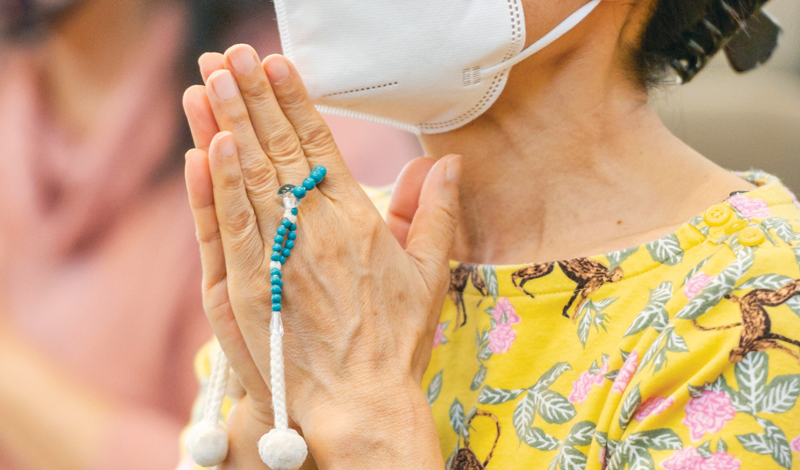Suffer what there is to suffer, enjoy what there is to enjoy. Regard both suffering and joy as facts of life, and continue chanting Nam-myoho-renge-kyo, no matter what happens. How could this be anything other than the boundless joy of the Law?
“Happiness in This World,”
The Writings of Nichiren Daishonin, vol. 1, p. 681
We practice Buddhism to enjoy a fulfilling life. Yet, being alive also entails facing all sorts of difficulties. The question is, What do we do when we encounter them?
In the passage above, Nichiren Daishonin lays out the essence of his teachings and the way to experience boundless joy in life. It is from a letter he wrote in 1276 to his stalwart disciple Shijo Kingo, a samurai who had fallen out of favor with his lord due to false accusations made by jealous colleagues.
“Suffer what there is to suffer and enjoy what there is to enjoy”—the Daishonin encourages Kingo that, while enjoyment and suffering are natural aspects of life, the deepest happiness can be found in any situation when we “continue chanting Nam-myoho-renge-kyo, no matter what happens.”
When we chant, we reveal our inherent, enlightened nature and can fully savor boundless and abiding joy derived from the essence of our lives—the power, wisdom, compassion and courage of the unchanging Mystic Law. With such an elevated state of life, we can use each challenge as an impetus for growing ever stronger, wiser and more compassionate.
—Prepared by the SGI-USA Study Department
Ikeda Sensei’s Encouragement
1. Find Joy and Appreciation in Everything
In times of suffering, chant daimoku. In times of joy, chant daimoku. Chanting daimoku is itself happiness. In life, there are both times of suffering and of joy. These are all irreplaceable scenes in life’s drama. Without suffering, we could not appreciate joy. Without knowing the flavors of both suffering and joy, we could not savor life’s profundity.
“Suffer what there is to suffer,” [Nichiren Daishonin] says. Suffering is inevitable in life. Therefore, we need to be prepared for hardship and to have the inner fortitude to rise above our worries and anxieties. We have to cause the “tranquil light of the moon of awakening”[1]—the world of Buddhahood—to shine in our lives. Then, earthly desires are transformed into enlightenment and we can use everything that happens in life to fuel our happiness.
To “enjoy what there is to enjoy” means to cause the “the wonderful lotus that is the inner nature of her mind”[2] to brightly blossom with a sense of appreciation and joy. Someone who can find joy, who can feel appreciation, experiences snowballing exhilaration and joy in life. Such is the heart’s function. (Learning From the Gosho: The Eternal Teachings of Nichiren Daishonin, pp. 244–45)
2. Find Deeper Meaning and Faith by Facing Reality Head-On
As human beings, we can’t escape from the sufferings of aging, sickness and death, but that doesn’t necessarily mean our lives will be unhappy. What we need to do is build an invincible, strong, expansive, rich state of life that doesn’t succumb to such sufferings as sickness and aging. Our Buddhist faith and practice are key to achieving that. Through our faith and practice, we can open the way to enjoying peace and security in our present existence and good circumstances in future existences.
Those who polish and train their spirit and dedicate themselves to the mission of kosen-rufu will be fulfilled and brimming with joy day after day, even though they may be old and in poor health. …
“Suffer what there is to suffer” doesn’t mean ignoring the existence of suffering; rather, it means facing reality head-on, viewing it from a Buddhist perspective. When perceived in that light, sickness and aging are more than meaningless suffering; instead, they become opportunities to rouse and deepen our faith. At the same time, we come to realize that sickness and aging are part of our mission to demonstrate to others the effectiveness of Buddhism.
“Enjoy what there is to enjoy” means to elevate the joys we experience in life to the level of eternal joy. The way to do that is to assiduously chant to the Gohonzon in a spirit of gratitude, elevate our life state and establish a condition of absolute happiness. The great path to indestructible happiness is found in consistently chanting Nam-myoho-renge-kyo, in times of both suffering and joy. (The New Human Revolution, vol. 24, pp. 184–85)
You are reading {{ meterCount }} of {{ meterMax }} free premium articles

